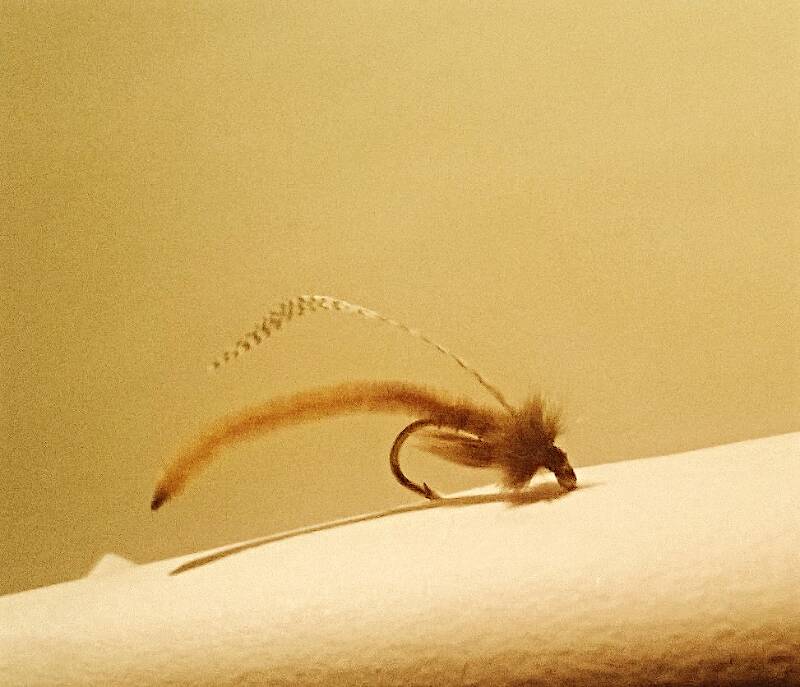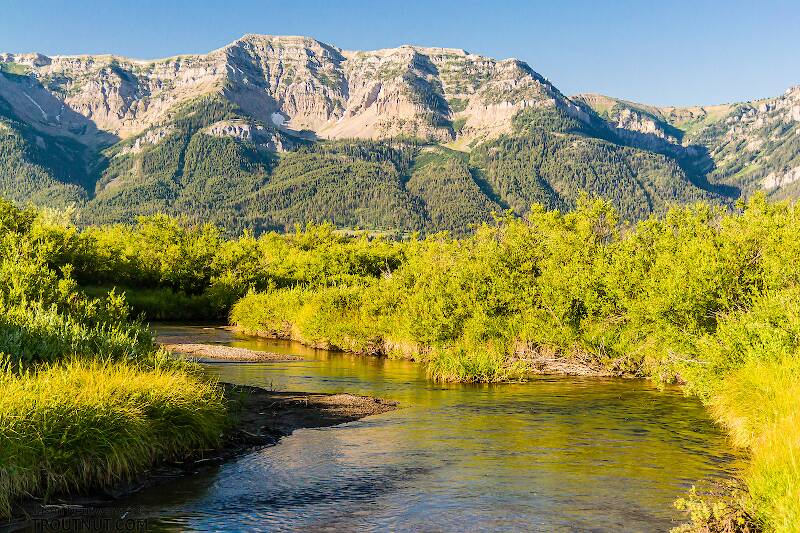
Hex Mayflies
Hexagenia limbata
The famous nocturnal Hex hatch of the Midwest (and a few other lucky locations) stirs to the surface mythically large brown trout that only touch streamers for the rest of the year.
Featured on the forum

This specimen keys pretty easily to Onocosmoecus, and it closely resembles a specimen from Alaska which caddis expert Dave Ruiter recognized as this genus. As with that specimen, the only species in the genus documented in this area is Onocosmoecus unicolor, but Dave suggested for that specimen that there might be multiple not-yet-distinguished species under the unicolor umbrella and it would be best to stick with the genus-level ID. I'm doing the same for this one.

Troutnut is a project started in 2003 by salmonid ecologist Jason "Troutnut" Neuswanger to help anglers and
fly tyers unabashedly embrace the entomological side of the sport. Learn more about Troutnut or
support the project for an enhanced experience here.

Stawheed on May 13, 2015May 13th, 2015, 5:02 am EDT
I am sorry if this is not the correct section but I can seem to find the appropriate section for questions regarding fly pattern identification.
I need to know the fly pattern name for the picture below.
I need to know the fly pattern name for the picture below.
Wbranch on May 13, 2015May 13th, 2015, 8:20 am EDT
I am unfamiliar with this pattern. In the US we have a pattern called the San Juan worm but the only similarity is it is tied entirely with a piece of, usually, brown or pink vernille. Vernille is a material like chenille but with a stiff core. Some fly fishers use it to imitate an earthworm.
I found this comment at another web site;
Here are two links, one to the San Juan worm and the other to the poopah which imitates caddis pupa.
http://thecatchandthehatch.com/wp-content/uploads/2014/01/beadhead-san-juan-worm-red-sku-549h-480x373.jpg
http://stevenojai.tripod.com/poopah.htm
I found this comment at another web site;
the more important feature to me is the the core of most chenille is cotton thread and the core of vernille is some sort of plastic thread
That becomes important when tying San Juan Worms or Poopah Caddis patterns. Both patterns call for melting the material so the exposed ends don't unravel. The chenille cotton core burns rather than melting..
Here are two links, one to the San Juan worm and the other to the poopah which imitates caddis pupa.
http://thecatchandthehatch.com/wp-content/uploads/2014/01/beadhead-san-juan-worm-red-sku-549h-480x373.jpg
http://stevenojai.tripod.com/poopah.htm
Catskill fly fisher for fifty-five years.
Entoman on May 13, 2015May 13th, 2015, 11:19 am EDT
Welcome to the forum.
It's a Fox Poopah. Obviously, the micro chenille body and duck flank antennae are grossly over length. I'm wondering about the tier's purpose for this curious distortion...
It's a Fox Poopah. Obviously, the micro chenille body and duck flank antennae are grossly over length. I'm wondering about the tier's purpose for this curious distortion...
"It's not that I find fishing so important, it's just that I find all other endeavors of Man equally unimportant... And not nearly as much fun!" Robert Traver, Anatomy of a Fisherman
Stawheed on May 14, 2015May 14th, 2015, 5:30 am EDT
Thank you guys for the swift reply and warm welcome. I am from Kashmir actually and there isn't much information regarding the fauna around trout streams. From last five years I am gathering information on food habits of trout around different seasons and with this the number of catch has increased but there is still a lot to do. Another worry is people here aren't much worried about the release part so am fighting that battle as well.
Coming to this fly pattern, all flies that are available in here are from UK since the sport was introduced by them during early 20th century and we have been following their Tackle ever since.
Anyways I went to fishing last week and there was this pool with a couple of good brownies and scores of new hatch around 5 inches in size. I tied this fly and the big ones didn't even bother to move but them little ones went mad even when I was retrieving the line for another cast. I felt sortta sad for their inexperience and about the selection of this fly which looked more like a worm than any insect.
Thank you again for the info.
Coming to this fly pattern, all flies that are available in here are from UK since the sport was introduced by them during early 20th century and we have been following their Tackle ever since.
Anyways I went to fishing last week and there was this pool with a couple of good brownies and scores of new hatch around 5 inches in size. I tied this fly and the big ones didn't even bother to move but them little ones went mad even when I was retrieving the line for another cast. I felt sortta sad for their inexperience and about the selection of this fly which looked more like a worm than any insect.
Thank you again for the info.
Quick Reply
Related Discussions
Topic
Replies
Last Reply
13
Jun 29, 2011
by Softhackle
by Softhackle
4
Sep 29, 2016
by Wiflyfisher
by Wiflyfisher



